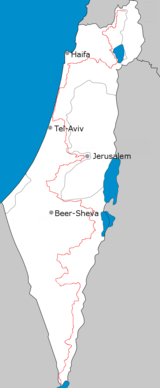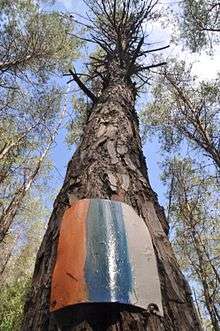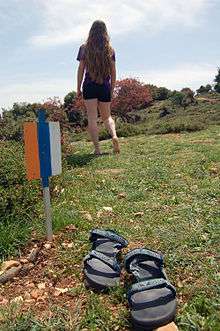Israel National Trail
The Israel National Trail (Hebrew שביל ישראל or Shvil Yisrael) is a marked trail along almost 1,000 km, crossing Israel from north to south.
- This article is an itinerary.
Understand

The Israel National Trail (INT) crosses historic places, archeological sites and unique landscapes while it zigzags its way from the northern border with Lebanon to the Red Sea through the Sea of Galilee region, Nazareth, Haifa, Tel Aviv, Jerusalem and the Negev (the Israeli desert.)
Consisting of 1000 kilometers of marked trail, the trail is a diverse path ranging from rivers in the north to the dryness and emptiness of the Negev in the south, to modern and busy Tel Aviv, to the ancient and holy city of Jerusalem.
Swimming in the Sea of Galilee and the Jordan River and visiting the Basilica of the Annunciation will take you to the places where Christianity was born. Walking in the land where the Bible stories unfold and seeing the evidence and the archeological sites of many familiar tales from childhood make the trail a holy and spiritual experience for every human being. Crossing many villages and towns, the INT is full of choices and possibilities.
One can sleep near civilization or be one with the wilderness. One can choose to carry five days of food or re-supply almost everyday. It is up to each individual to decide what kind of INT experience is right for him/her.
The INT gives one the chance to experience superb desert scenery in a relatively accessible way. When hiking the INT, one is never more than a one day's hike from a road or two days to a reliable water source. Magnificent desert colors, animals and flowers are some of the many wonderful highlights.
In Israel, the majority of people speak English as a second language and are more than willing to help. One will not recognize this picturesque Israel from the pictures seen on television news, which typically only depict the conflict which occurs in small sections of a largely conflict-free land. One who visits will have a better understanding of the place that is constantly in world headlines.
Route
North to south:
This is the most common way, and it has certain benefits:
- The northern part is easier and gives your body a better chance to get in shape, acclimatize and adjust to the trail life. The amount of water you need to carry is smaller and again it gives your body time to get stronger.
- During the spring start in early March or late February in Eilat. You will each the north with all the green and flowers still at their peak.
- In spring consider starting in Tel Aviv and go south. From Eilat take a bus to Dan and go to Tel Aviv. The finish in Tel Aviv is very rewarding.
- The finish line of Eilat is generally more rewarding than the region of Dan in the north. Eilat is a resort town filled with luxury hotels, which will likely be more relaxing and rewarding than Kibbutz Dan's, especially when contrasted to the desert that one is exiting.
- There are many more villages and kibbutzes on the northern part with more resupply possibilities. For most of the hikers it's the first long trail they have experienced and many mistakes are made with water, food and gear. These mistakes are much easier to ¨fix¨ on the northern part of the trail. By the time one gets to the desert, important lessons on water and food quantities and gear should have been learned.
- Expect however more rainy days in the north during March-April and consequently more delays.
South to north:
- If one is hiking in the spring it makes more sense to hike the desert section before it gets too hot. Hiking in May in the desert is associated with more very hot days when one must stop the day's hike at about 10AM and continue hiking in the afternoon, when temperatures drop.
- There is a higher likelihood of experiencing desert floods after a heavy rain, which are beautiful. However, such rains and floods can also be dangerous. Floods are not frequent in the desert section of INT.
Galilee
Galilee Panhandle (Kibbutz Dan, Tel Dan, Hasbani River, Ma'ayan Baruch, Kfar Giladi, Tel Hai), Mount Meron, near Safed (Upper Galilee), Hukok (Kibbutz), Mount Arbel, Sea of Galilee, Tiberias, Jordan River, Mount Tavor, Nazareth, Zippori
Carmel Range
Yagur (Kibbutz), Carmel Range, Nahal Me'arot Nature Reserve, near Zikhron Ya'akov
Coastal Plain
Caesarea, Hadera, Nahal Alexander, Netanya, Herzliya, northern Tel Aviv, Antipatris, Givat HaShlosha (Kibbutz near Petah Tikva), Mazor Mausoleum
Shfela and Jerusalem Mountains
Ben Shemen Forest, Ajalon, Latrun, Burma Road, Tzova (Kibbutz), near Jerusalem (connecting to the Jerusalem Trail), Netiv HaLamed-Heh (Kibbutz), Beth Guvrin, Tel Lachish
Negev
Dvir (Kibbutz), Lahav (Kibbutz near Lehavim), Metar, Arad, HaMakhtesh HaKatan, Sde Boker (Kibbutz), Mitzpe Ramon, Arabah, Neot Semadar (Kibbutz), Timna Valley, Eilat Mountains, Eilat
Prepare


- Also consult the guide for Hiking and Backpacking in Israel
The trail is approximately 1000 km (625 miles) long. For the average hiker, it should take from 40 to 60 days.
When to go
There are two good seasons: October to November, and February to mid-May. During February to mid-May, the landscape is green and the flowers are blooming, more water is available in the creeks, and the rivers up north are much more impressive. Winter is also a good time to hike the INT. In both seasons you can expect rain in the northern part of the trail. A tent or tarp and rain gear would be good to have in winter.
Supplies and water
The trail passes near towns and places where one can buy food and resupply more often than you need. One wouldn’t need to carry more than five day's worth of food. Every village, town and kibbutz usually has a grocery store. As may be expected, the bigger the community, the bigger and better-supplied the stores will be.
Until one gets to Arad traveling southward (assuming no abnormally hot conditions), five liters per person per day should be enough for drinking and cooking. More would be necessary for "bottled showers" or dish-washing. There is no place along this northern part that one would need to carry more than one day's water supply.
From Arad to Eilat six to seven liters per day are needed. One would have a 2-3 days between water sources. You should cache water in the desert in designated places. On hot days (over 30°C) more water is needed.
There are many places that extra water supplies would be useful to have "stashed" ahead of time on the trail. South of Arad (Wadi Hemar, Meizad Tamar), bottom of small crater, the large crater (north & south), Ein Akev or Wadi Hava, Wadi Geled, before Barak Canyon, wadi Zihor, Shehoret Canyon and Ein Netafim. A complete updated list of water points is available from the ITC.
Safety
The trail is only close to disputed territories in one place - near Lahav. Lahav area is very safe to hike and it has been like that for decades. Carrying a weapon is completely unnecessary.
There has never been a reported incident of anyone, foreign or national, experiencing conflict on the trail. Contrarily, many hikers have reported that they have been welcomed both by Arab and Jewish communities through which the trail passes.

Trail markers
The trail is marked all the way in orange, blue and white. The "up" color points the direction. White up it's north, Orange up south. It's difficult to get lost.
Costs
In general, the trail does include any fee. Having said that, crossing through a national park, the park might you require to pay a fee. For instance, the Israel National Trail goes straight through Timna Park before Eilat, which has a steep entrance fee of ₪49. For other parks best consult a map.
Resources
In 2016 the third edition of the guide in English was published. The guide contains highly detailed topographical maps (1:50,000) of the trail in English, a hike description in both southbound and northbound direction, and a lot of useful information about the trail. The cost of the guide + maps is very reasonable.
There is also an excellent Guide in Hebrew published by the Israeli publisher "Eshkol". It includes all the topographical maps of the trail.
There are highly detailed topographical maps of Israel as well. They are currently available from the ITC directly or at book stores, but they are Hebrew-only and rather expensive (around 100 shekels). Water sources are marked, but they're not reliable. There are no recommendations on places to stay or good campsite markers on the ITC maps.
There are some English resources on the trail:
- English language guide book. Hike the land of Israel, all the topographical maps of the INT in English (1:50,000) are included in the INT guide book. ISBN 9789659124947.
- List of trail angels in English
- Israel National Trail forum
- Israel Trails Committee (ITC), 2 HaNegev, Tel Aviv 66186, ☎ +972-3-6388719, +972-3-6388720, e-mail: shvil@spni.org.il. Offers substantive information on water points and shelter, including a list of "Trail Angels" (the list is in Hebrew). The Trail Angels accept Israel Trail hikers into their homes (for a shower, and some for a night's accommodation or a hot meal) which lie adjacent to or in close proximity to the trail. The ITC also has a hotline for problems encountered on the trail.
- The ITC offers a (Hebrew-only) seminar on hiking the Israel Trail.
- Maps (in Hebrew) - A set consists of 14 laminated topographical maps, costing ~US$20 per map. Each map weighs about 150 grams (~5 ounces). A free downloadable version is available here.
- Walk About Love Journey - Annual journey walking of the entire trail in an international group open to everyone
- "Walk the Land - A Journey on Foot through Israel", ISBN 9780975961957, a travel memoir
- Jesus Trail - This website has maps and GPS tracks for a large portion of the Israel Trail in the Galilee (Migdal to Tabor), as well as detailed planning information for hiking in Israel
- Israel National Trail - Maps, guides & other resources.
History
When Avraham Tamir, a journalist and writer (for the children's magazine, Thing for Children), hiked the Appalachian Trail in 1980, he came up with the inspiration for the Israel Trail. Upon returning to Israel, Tamir approached ITC (ITC, the Israel Trails Committee, is housed by SPNI, the Society for the Protection of Nature in Israel) Director Ori Devir with the idea. A long-time veteran and founder of SPNI, Ori Devir contemplated the idea, fell in love it, and began the long process of establishing the Trail. Devir and his team collected ideas and feedback from tour guides, park rangers, hikers and veteran nature lovers. After much investigation, bureaucracy and hard work, 15 years later ITC opened the Israel Trail with then President Ezer Weitzman conducting the ceremony on Passover 1995.
Most of the Israel Trail was patched together from the network of thousands of kilometers of pre-existing trails across the country. The trail system stringently protects environmental concerns and each region's character. The Israel Trail was intended for hiking by foot only, but as a result of jeeps driving the trails, some sections of the trail are now accessible not only to jeeps, but to regular private cars. You can get to the trail by foot, car and even public transit. Along the trail, informational signs feature maps, background on the area and interesting sites, trail rules and emergency phone numbers.
In 1994, Yariv Ya'ari was the first person to hike the entire Israel Trail and he completed the trail in 21 days. More and more people began to hike the Israel Trail and today tens of thousands of people hike the Israel Trail every year! In October 2006, Avraham Tamir's young son Mickey Tamir hiked the Israel Trail to mark his father's 100th birthday and his own 60th birthday. Thousands of groups hike a section of the Israel Trail, hiking once a month or so, until they complete the entire trail within two years.